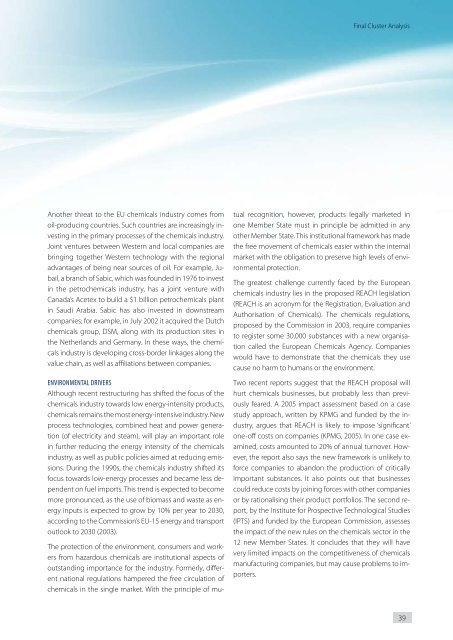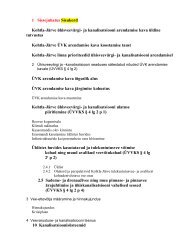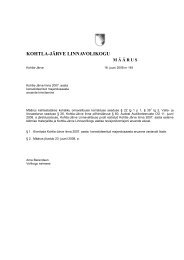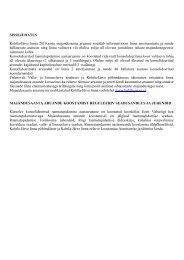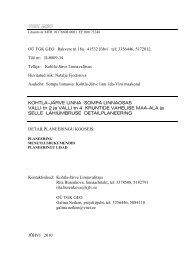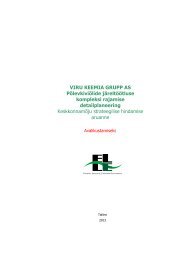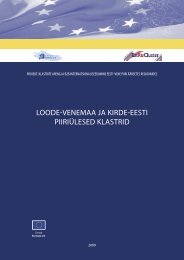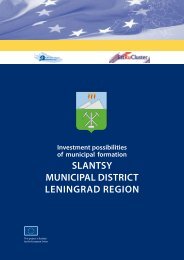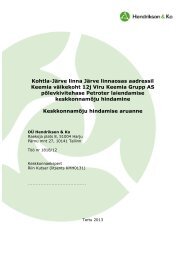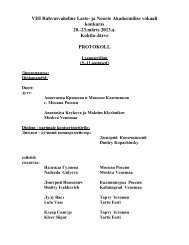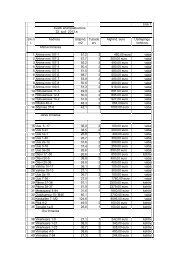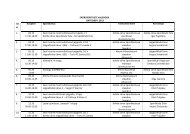FINAL CLUSTER ANALYSIS - Kohtla-Järve
FINAL CLUSTER ANALYSIS - Kohtla-Järve
FINAL CLUSTER ANALYSIS - Kohtla-Järve
Create successful ePaper yourself
Turn your PDF publications into a flip-book with our unique Google optimized e-Paper software.
Another threat to the EU chemicals industry comes from<br />
oil-producing countries. Such countries are increasingly investing<br />
in the primary processes of the chemicals industry.<br />
Joint ventures between Western and local companies are<br />
bringing together Western technology with the regional<br />
advantages of being near sources of oil. For example, Jubail,<br />
a branch of Sabic, which was founded in 1976 to invest<br />
in the petrochemicals industry, has a joint venture with<br />
Canada’s Acetex to build a $1 billion petrochemicals plant<br />
in Saudi Arabia. Sabic has also invested in downstream<br />
companies; for example, in July 2002 it acquired the Dutch<br />
chemicals group, DSM, along with its production sites in<br />
the Netherlands and Germany. In these ways, the chemicals<br />
industry is developing cross-border linkages along the<br />
value chain, as well as affi liations between companies.<br />
envIronmental DrIvers<br />
Although recent restructuring has shifted the focus of the<br />
chemicals industry towards low energy-intensity products,<br />
chemicals remains the most energy-intensive industry. New<br />
process technologies, combined heat and power generation<br />
(of electricity and steam), will play an important role<br />
in further reducing the energy intensity of the chemicals<br />
industry, as well as public policies aimed at reducing emissions.<br />
During the 1990s, the chemicals industry shifted its<br />
focus towards low-energy processes and became less dependent<br />
on fuel imports. This trend is expected to become<br />
more pronounced, as the use of biomass and waste as energy<br />
inputs is expected to grow by 10% per year to 2030,<br />
according to the Commission’s EU-15 energy and transport<br />
outlook to 2030 (2003).<br />
The protection of the environment, consumers and workers<br />
from hazardous chemicals are institutional aspects of<br />
outstanding importance for the industry. Formerly, diff erent<br />
national regulations hampered the free circulation of<br />
chemicals in the single market. With the principle of mu-<br />
Final Cluster Analysis<br />
tual recognition, however, products legally marketed in<br />
one Member State must in principle be admitted in any<br />
other Member State. This institutional framework has made<br />
the free movement of chemicals easier within the internal<br />
market with the obligation to preserve high levels of environmental<br />
protection.<br />
The greatest challenge currently faced by the European<br />
chemicals industry lies in the proposed REACH legislation<br />
(REACH is an acronym for the Registration, Evaluation and<br />
Authorisation of Chemicals). The chemicals regulations,<br />
proposed by the Commission in 2003, require companies<br />
to register some 30,000 substances with a new organisation<br />
called the European Chemicals Agency. Companies<br />
would have to demonstrate that the chemicals they use<br />
cause no harm to humans or the environment.<br />
Two recent reports suggest that the REACH proposal will<br />
hurt chemicals businesses, but probably less than previously<br />
feared. A 2005 impact assessment based on a case<br />
study approach, written by KPMG and funded by the industry,<br />
argues that REACH is likely to impose ‘signifi cant’<br />
one-off costs on companies (KPMG, 2005). In one case examined,<br />
costs amounted to 20% of annual turnover. However,<br />
the report also says the new framework is unlikely to<br />
force companies to abandon the production of critically<br />
important substances. It also points out that businesses<br />
could reduce costs by joining forces with other companies<br />
or by rationalising their product portfolios. The second report,<br />
by the Institute for Prospective Technological Studies<br />
(IPTS) and funded by the European Commission, assesses<br />
the impact of the new rules on the chemicals sector in the<br />
12 new Member States. It concludes that they will have<br />
very limited impacts on the competitiveness of chemicals<br />
manufacturing companies, but may cause problems to importers.<br />
39


